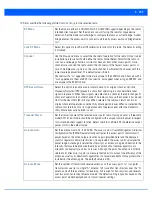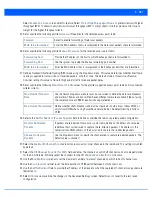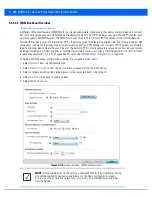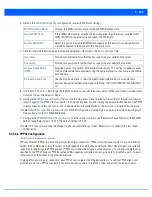
5 - 267
5.4.5.4 Overriding the Network Configuration
Setting a network configuration is a large task comprised of numerous administration activities. Each of the configuration
activities described can have an override applied to the original configuration. Applying an override differentiates the device
from the profile’s configuration and requires careful administration to ensure this one device still supports the deployment
requirements within the network.
A profile’s network configuration process consists of the following:
•
Overriding the DNS Configuration
•
Overriding an ARP Configuration
•
Overriding a L2TPv3 Profile Configuration
•
Overriding IGMP Snooping Configuration
•
Overriding MLD Snooping Configuration
•
Overriding a Quality of Service (QoS) Configuration
•
Overriding a Spanning Tree Configuration
•
Overriding a Routing Configuration
•
Overriding a Dynamic Routing (OSPF) Configuration
•
Overriding a Forwarding Database Configuration
•
Overriding a Bridge VLAN Configuration
•
Overriding a Cisco Discovery Protocol Configuration
•
Overriding a Link Layer Discovery Protocol Configuration
•
Overriding a Miscellaneous Network Configuration
•
Overriding Alias Configuration
5.4.5.4.1 Overriding the DNS Configuration
Overriding the Network Configuration
Domain Naming System
(DNS) DNS is a hierarchical naming system for resources connected to the Internet or a private
network. Primarily, DNS resources translate domain names into IP addresses. If one DNS server doesn't know how to translate
a particular domain name, it asks another one until the correct IP address is returned. DNS enables access to resources using
human friendly notations. DNS converts human friendly domain names into notations used by different networking equipment
for locating resources.
As a resource is accessed (using human-friendly hostnames), it’s possible to access the resource even if the underlying machine
friendly notation name changes. Without DNS you need to remember a series of numbers (123.123.123.123) instead of a
domain name (www.domainname.com).
To define the DNS configuration or apply overrides to an existing configuration:
1. Select
Devices
from the Configuration tab.
2. Select
Device Overrides
from the Device menu to expand it into sub menu options.
3. Select a target device from the device browser in the lower, left-hand, side of the UI.
4. Select
Network
to expand its sub menu options.
5. Select
DNS
.
Summary of Contents for WiNG 5.7.1
Page 1: ...WiNG 5 7 1 ACCESS POINT SYSTEM REFERENCE GUIDE ...
Page 2: ......
Page 3: ...WING 5 7 1 ACCESS POINT SYSTEM REFERENCE GUIDE MN001977A01 Revision A April 2015 ...
Page 4: ...ii WiNG 5 7 1 Access Point System Reference Guide ...
Page 24: ...1 4 WiNG 5 7 1 Access Point System Reference Guide ...
Page 36: ...2 12 WiNG 5 7 1 Access Point System Reference Guide ...
Page 72: ...3 36 WiNG 5 7 1 Access Point System Reference Guide ...
Page 470: ...5 386 WiNG 5 7 1 Access Point System Reference Guide ...
Page 472: ...6 2 WiNG 5 7 1 Access Point System Reference Guide Figure 6 1 Configuration Wireless menu ...
Page 624: ...7 46 WiNG 5 7 1 Access Point System Reference Guide ...
Page 724: ...9 56 WiNG 5 7 1 Access Point System Reference Guide ...
Page 783: ...12 35 Figure 12 46 Device Summary screen 4 Click File Management ...
Page 816: ...12 68 WiNG 5 7 1 Access Point System Reference Guide ...
Page 1006: ...13 190 WiNG 5 7 1 Access Point System Reference Guide ...
Page 1026: ...14 20 WiNG 5 7 1 Access Point System Reference Guide ...
Page 1028: ...A 2 WiNG 5 7 1 Access Point System Reference Guide ...
Page 1089: ......
Page 1090: ...MN001977A01 Revision A April 2015 ...
















































